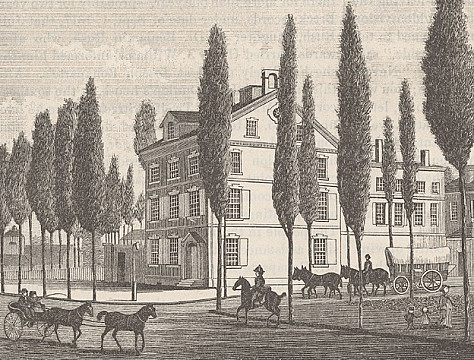Gilman Mansion
4 Oak Street, Brunswick, Maine
Built in 1799, for Captain John Dunlap (1738-1824) and his second wife, Mary Tappan (1730-1838). Their white-washed, colonial mansion on the corner of Union and Oak Streets in Brunswick still stands today and contains 50-rooms. Also known as the John Dunlap House, the property passed by marriage to the Gilmans and stayed in the Dunlap-Gilman family until 1946. Today, it is subdivided into apartments....

By 1803, Dunlap had officially become the wealthiest man in the State of Maine having amassed a personal fortune estimated at $200,000 through a combination of the fur-trade, the lumber business and navigation. Four years before, he employed the master builders, Samuel and Aaron Melcher of Brunswick to build him a home reflective of the wealth he had created. The result was a 24-room Colonial mansion with balustraded roof and arched dormer windows set in its own small park with fountain-like elms, a sundial, and views that drifted down to the Androscoggin River that were unrivalled in Brunswick.
The John Dunlap House
The John Dunlap House
A three-story ornamental mahogany staircase rises from the first floor to the garret in a continuous spiral giving access to all the rooms in the main block. The principal reception rooms were panelled in Brunswick white pine and the two drawing rooms opened up onto one another to measure 50-feet in length and were finished with gold embossed wallpaper lit by crystal chandeliers, both sourced from France. There were nine fireplaces and it was furnished with rare antiques, family portraits, historic relics and collections of pewter.
Following the Captain's death, the house passed to his eldest surviving son, David Dunlap (1778-1843). David was a wealthy and well-respected Brunswick merchant in his own right and a half-brother of General Richard Dunlap and Robert P. Dunlap (1794-1859), 11th Governor of Maine. David married Nancy McKeen (1788-1849), the eldest daughter of the 1st President of Bowdoin College. In 1841, he remodelled the house but died two years later.
The Dunlap-Gilmans
The Dunlap-Gilmans
Following the death of her mother in 1849, David and Nancy's daughter, Alice McKeen Dunlap (1827-1905), became the mansion's sole heiress. In 1850, she married Congressman Charles Jervis Gilman (1824-1901) who quit his successful legal practice in Exeter, New Hampshire, to take up the life of a country squire at the Dunlap mansion. Both the house and the avenue by which it was approached became known as Gilman Mansion and Gilman Avenue as a mark of respect by the townspeople to Charles Jervis Gilman.
The Gilmans were the parents of two sons and two daughters. Their eldest son, David Dunlap Gilman (1854-1914), was succeeded at the house by his younger brother, Charles Ashburton Gilman (1861-1937), and Charles' wife Martha Brown Ellison (1871-1949). When Charles died, the house passed to his sister, Mary (d.1940), who gave it to Charles' widow, Mrs Martha (Ellison) Gilman. Six years later (1946), Martha finally sold the property. By 1956, it was home to a Mr George Foster and in 1979 it was added to the National Register of Historic Places. Today, it still stands, but divided into apartments.
Categories
Styles
Share
Connections
Be the first to connect to this house. Connect to record your link to this house. or just to show you love it! Connect to Gilman Mansion →


